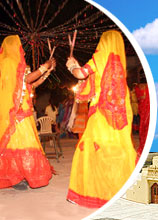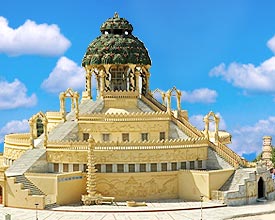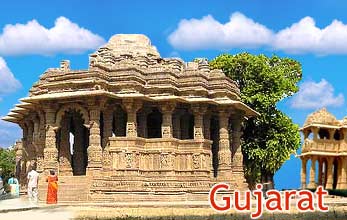Chitra-Vichitra Mela is a purely tribal fair that
takes place in the Gumbhakhari village, which falls under the
Sabarkantha district. The village is located almost on the border of
Rajasthan and Gujarat. The venue of the fair is near a temple
overlooking the rivers Sabarmati, Aakar and Vakar. Chitra-Vichitra Mela
is a huge hit amongst all the tribes of the state. A large number of
Bhils from the surrounding areas reach the venue, for the celebration of
the spring event, just a fortnight after Holi.
There is an exciting story behind the Chitra Vichitra Mela of India.
The historical relevance of the fair dates back to the Mahabharat era.
It is said that there were two sons of Shantanu named Chitraveer and
Vichitraveer. Both of them wished to repent for the sins they had
committed. A meditating saint advised them to discover a place, where
the meeting point of three rivers as well as a Shiva shrine was located.
Abiding by the saint's advice, they began their search and came to this
ancient place, which is now known as Chitra Vichitra.
In order to practice penance, they immolated themselves here. Since
then the Chitra- Vichitra fair is organized here in the memory of the
two princes. The tribal population celebrates the fair every year, on
the confluence of the rivers Sabarmati, Aakar and Vakar. It commences on
the eve of no moon day just after Holi. On this night, the tribal people
gather on the banks of the river and mourn for their departed dear ones.
They also sing sorrowful songs, offer sacrifices and finally bathe in
the river.
But in the morning, the mood is completely transformed. The people are
completely taken over by the festive mood. The fair takes the form of a
colorful galore owing to the vibrant traditional clothes of the Bhils
and Garasias. The Garasia women are usually dressed in bright blue,
green and red saris or Ghaghras (long skirts). They team it up with
heavy silver jewelry like ear rings, necklaces and tingling anklets. To
make themselves look further attractive they put kajal in their eyes and
red color on their lips and cheeks.
On the other hand, men wear a blue shirt, dhoti and a red or saffron
turban on head. In contrast to this, the Bhils, though well dressed, are
less ornately jeweled. On an average, around 60,000 to 70,000 tribals
participate in this fair. Men beat drums which are accompanied by folk
songs sung by the women. It is followed by dancing in merriment, till
everyone is exhausted. After this, the stalls selling food, refreshment,
drinks and sweets are surrounded by the mob of people. One can buy
various household items and silver jewelry from here.
Children enjoy themselves in the giant wheel and the merry-go-round.
The fair is also popular as a betrothal ground for the young tribal boys
and girls. Young men and women attend this fair to find a suitable match
for themselves. They even elope with each other to the forest adjacent
to the river. After some days, they return to their community to get
married. It is a common practice amongst the Bhils and the Garsias.








